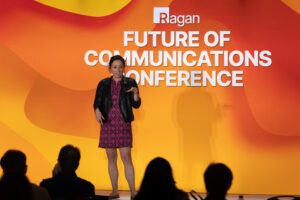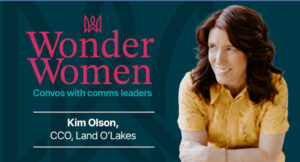PR lessons from Boeing, Starbucks CEO changes

Parallel stories are playing out in Seattle with two legacy brands grappling with poor performance, employee issues and a loss of direction. Both Starbucks and Boeing are hoping that their new CEOs can turn things around – but both have their work cut out for them.
Jennifer George, SVP at The Aspen Group, sees similarities in how they’re communicating change under their new leaders, Kelly Ortberg at Boeing and Brian Niccol at Starbucks. Each of these companies is using the messaging around the hires to signal to the outside world that they’ll be going back to the services and brand characteristics that made them household names decades ago.
According to George, who has experience with leadership changes at brands like Shutterfly and Unilever, successful change leadership requires “brutal honesty about problems, deep respect for heritage, clear frameworks for action, authentic engagement with front-line teams and realistic timelines.”
Heritage as North Star
Sometimes new CEOs want to make their mark by building something new, but they shouldn’t forget what made their organization great in the first place, George said. “Your company’s history and the DNA of that brand are really a strength.”
At Boeing, the comms team is focusing on returning to engineering excellence, while Starbucks wants to get back to its “coffeehouse roots.” In his hiring announcement, Niccol stressed a desire to see the “iconic brand” get back to exhibiting the “unique culture and commitment to enhancing human connections around the globe” that he has long admired.
“It’s clear we need to fundamentally change our strategy to win back customers,” Niccol said in mid-October. “My experience tells me that when we get back to our core identity and consistently deliver a great experience, our customers will come back.”
Mellody Hobson, Starbucks’ lead independent director and a board member, described Niccol as a “culture carrier.” She and the rest of the company’s board praised Niccol for turning Chipotle around by introducing menu changes and improving store employees’ quality of life, through higher wages and more benefits.
“Like all of us at Starbucks, he knows that a great customer experience starts with a great partner experience,” said Hobson. “Our board believes he will be a game-changing leader for our company, our people, and the customers we serve worldwide.”
In his early days as Boeing’s CEO, Ortberg made a deliberate effort to spend time on the factory floor, rather than in the executive suites: “I don’t think our people are close enough to the people in the labs, the people on the factory floor.”
The statement showcased Ortberg’s commitment to connecting with frontline employees who are the “lifeblood of the company,” George said.
In other statements, the former Collins Aerospace chief executive has tried to send a message to investors that Boeing was getting back to basics. He recently cited a desire to develop a new aircraft in the future but stressed a need to “reset our priorities and create a leaner, more focused organization.”
“There was no attempt to ‘reimagine aerospace solutions,'” George said. “It was, ‘We’re an airplane company; and we need to get back to what we do best, which is engineering excellence around airplanes.'”
Front-line first
George emphasized that Niccol and Ostberg’s post-hire actions weren’t about making boardroom presentations, but rather about taking trips into the field. “Truth comes from where value is created, not headquarters,” George said.
Both CEOs have been clear about the importance of being in the trenches. Niccol did just that in his first 50 days, talking to folks all over the country on a listening tour.
As part of his “Back to Starbucks” plan, Niccol is simplifying the drink and food menus, restoring the condiment bar and bringing back the practice of writing names on beverage cups, among other changes, to reclaim the company’s status as “America’s living room.”
“To me, the fact that he’s turned what he heard into tangible changes in under three months sends a clear message about understanding the people doing the actual work and making it easier for them, which ultimately benefits customers,” George said.
They’ve also worked to show that commitment isn’t a one-off thing. Ortberg, for instance, moved from Florida to Seattle. Niccol is commuting by private jet from his family home in Southern California to be at the office a few times a week. Though, that work agreement with has raised some concerns about an apparent double standard as the company has pledged to enforce its return-to-office policy.
“The real challenge is the perceived inconsistency, whether it’s real or not,” George said. “As I always tell leaders, everything you say and do sends a message. Your job as CEO is to send the right message and inspire trust. To me, this doesn’t quite hit the mark.”
A Starbucks spokesperson said corporate expectations are for Niccol to work in the Seattle office at least three days a week in line with the company’s policy.
“It seems like they tried to do this with the right intention, but it still raises questions about consistency and fairness,” George said.
Framework, not frenzy
George praised both companies for their straightforward language in communications. “There are very few buzzwords or corporate jargon,” she said. “They’re willing to admit the hard truth, that they’ve made it difficult to be a customer.”
One example is Ostberg’s frank statements about the looming layoff of up to 10% of Boeing’s staff.
In the Q3 earnings report, he wrote:
“We are at a crossroads. The trust in our company has eroded; we’re saddled with too much debt; and we’ve had serious lapses in our performance across the company, which have disappointed many of our customers.”
“As communications pros, we often sanitize our leaders’ messages, making them meaningless and undermining trust,” she said. “Real trust is built on raw truth, not perfectly crafted statements.”
George noted that communications from Niccol and Ortberg, as well as their teams, have used simple, direct language that “calls out problems by name and strips away the corporate veneer.”
“They speak like humans, saying what’s wrong and how they’ll fix it, which has been really powerful for both of them so far,” she added.
George emphasized the importance of setting long-term expectations while trying to get back to the fundamentals and earning a few wins.
“Change is a process, not an event,” George said.
Casey Weldon is a reporter for PR Daily. Follow him on LinkedIn.







